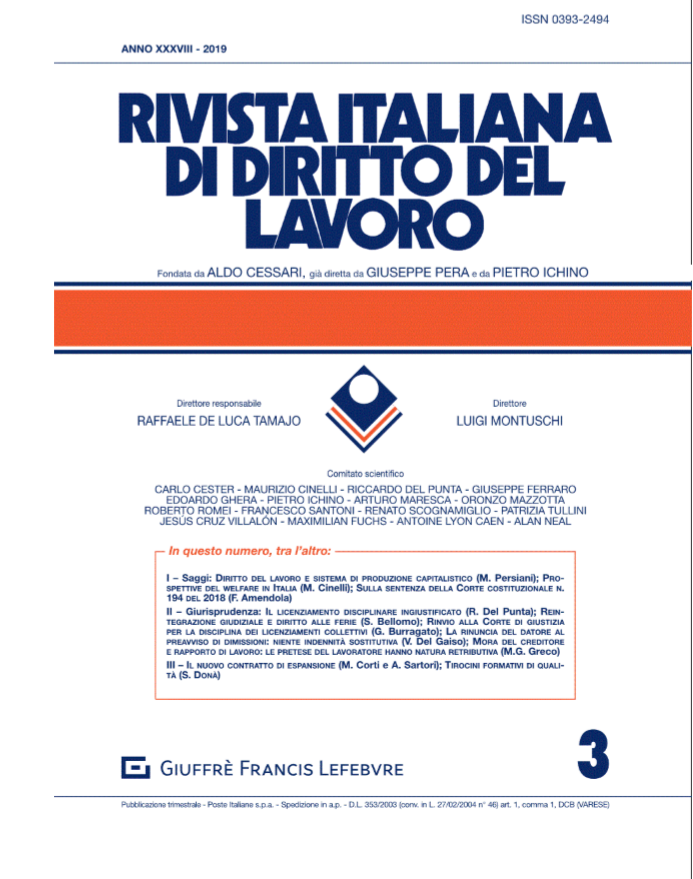IL REGIME SANZIONATORIO DEL LICENZIAMENTO ALLA DERIVA DEL DIRITTO LIQUIDO
CARLO PISANI
Professore ordinario dell’Università di Roma “Tor Vergata”
in Rivista Italiana di Diritto del Lavoro n. 3/2019
SOMMARIO: 1. Diritto “liquido” e instabilità del diritto – 2. Un esempio di diritto liquido: Corte Cost. n. 194/2018 – 3. Altro caso emblematico: il “può” significa “deve” reintegrare – 4. L’(ab)uso dell’interpretazione costituzionalmente orientata.
Il saggio analizza alcune tendenze del diritto nella post-modernità, ben espresse dalla metafora del diritto liquido, in quanto evidenzia la provvisorietà delle sue preposizioni, sempre suscettibili di mutare, con ritmi di cambiamento mai conosciuti prima d’ora. Una delle manifestazioni più significative di questa liquidità viene vista nel ruolo sempre più creativo della giurisprudenza, con i conseguenti rischi di incertezza del diritto. Vengono poi esaminati due casi emblematici di diritto liquido nell’ambito del diritto del lavoro, entrambi riguardanti il regime sanzionatorio del licenziamento ingiustificato. Il primo concerne la sentenza della Corte Costituzionale n. 194/18 che ha amputato l’art. 3, co. 1, d. lgs. n. 23/15 del meccanismo delle tutele crescenti, lasciando in vita una norma monca, senza criteri definiti chiaramente per legge, ma rinviando totalmente alla discrezionalità del giudice per la determinazione dell’indennità per il licenziamento illegittimo da un minimo di sei a un massimo di trentasei mensilità. L’altro esempio di diritto liquido è stato visto nelle sentenze della Cassazione che ha interpretato la previsione dell’art. 18, comma 7 l. n. 300/70, secondo cui il giudice “può” disporre la reintegra, come se vi fosse scritto che “deve” disporre la reintegra, ignorando totalmente il senso fatto palese dal significato delle parole. Si è infine criticato l’uso eccessivo dell’interpretazione costituzionalmente orientata, quale tecnica per ricavare dalla norma prescrizioni gradite all’interprete ma contrarie al tenore letterale della disposizione.
The essay analyses some trends in post-modernity law, well expressed by the metaphor of “liquid law”, as it highlights the temporariness of Law provisions, always subject to changes, with unprecedented rhythm. The increasingly creative role of case-law, with consequent risks of legal uncertainty, is one of the most significant manifestations of such uncertainty. Two emblematic examples shall be examined, both concerning the sanctioning regime against unjustified dismissal. The first concerns Judgment No. 194/18 of the Constitutional Court, which amended Article 3, paragraph 1 of the Italian Legislative Decree no. 23/2015, regulating the calculation of employees’ increasing allowances. These amendments leave the above-mentioned provision with no clear criteria for calculating the indemnity for unlawful dismissed employees, this,allowing full discretion to the Judge (from a minimum of six to a maximum of thirty-six months). The second example regards some Judgments of the Supreme Court, which manipulated the provision of Article 18, paragraph 7, of Italian Law No 300/70. Such provision states that the Judge “may” order the reinstatement in specific cases; however, it has been interpreted as it stated that the Judge “must” order the reinstatement, completely ignoring the wording of the Law. Finally, the essay criticizes the excessive use of constitutionally oriented interpretation, as such technique sometimes is adopted for obtaining prescriptions which are not consistent with the wording of the Law.

